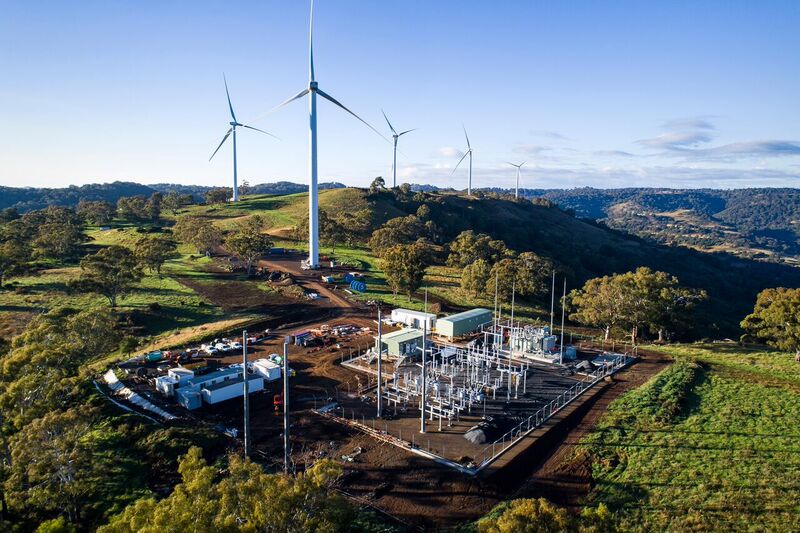White Rock Wind Farm


In the hills of NSW’s New England Tablelands there is a frenzy of activity, day and night, as White Rock Wind Farm, owned by CECEP and Goldwind, nears completion. The wind farm is being built to provide a clean, renewable energy source – enough to power 75,000 homes annually. Stage 1 of the White Rock Wind Farm project consists of 70 turbines that will produce 175 MW of electricity.
Amongst countless contractors bringing this renewable energy project to life is Zinfra, who is putting the finishing touches on the newly constructed 132/33kv substation, secondary and auxiliary systems buildings and a dual circuit eight kilometre transmission line, to tie the new energy source into TransGrid’s network.
Throughout the project a consultative approach, coupled with Zinfra’s extensive network and electrical knowledge, has led to improved construction methodologies for TransGrid. Using in-house resources, Zinfra has delivered a broad range of capabilities including electrical, construction, testing and commissioning, pre-energisation commissioning, construction works, SCADA and communications, fibre and the cutting in of new feeders.
Like all projects of this size, delivery has not been without its challenges. The biggest hurdle Zinfra faced from the outset of the project was an accelerated schedule. The original delivery timeframe of 35 weeks was shortened by 90 days: that’s a 35% reduction before work even began.
As a national company, with extensive resources, Zinfra was able to mobilise extra resources to site in a short time frame to meet this accelerated delivery schedule. Electricians, linesman, testing and commissioning employees and their support team were brought in to expedite works.
Zinfra’s suppliers also pulled out all stops to help meet tight targets. Secondary systems building fabricator ICS Industries delivered their buildings ahead of schedule, and civil contractor TP Turners worked collaboratively with Zinfra to produce clever solutions to help beat the clock.
Civil works for the substation site were planned in such a way that the different site areas were delivered in stages in order for Zinfra to commence electrical construction while civil works continued concurrently. The civil team also provided invaluable time saving measures to counter the other big challenge facing crews at the wind farm: inclement weather.
The weather at White Rock Wind Farm is highly changeable and can be wet and, obviously, windy. Wet weather however has proved the greatest nemesis for this project. A single day of rain can lead to two weeks of down-time as wet, muddy and slippery conditions make heavy machinery use impossible.
The civil team prepared the substation site in such a way as to mitigate the risk of down time from a downpour. They graded the site well and put down swathes of sheeting to assist with run off, and facilitate a fast return to work for the construction teams after rain.
Access on site, which extends over a 10 kilometre range was via a single road on which all contractors had to travel. Constructed for the project, the road was subject to the vagaries of wet weather, the landholders’ livestock and the frequent oversized deliveries of turbine blades and parts.
The eight kilometre dual circuit transmission line runs from the existing TransGrid network at the bottom of the site location, at approximately 900 metres above sea level and ends at the substation 1200 metres above sea level. The line includes two long spans – one 600 metres and the other 900 metres – to breach deep ravines along its path.
The steep terrain and wet conditions meant getting in to clear an easement and erect the 47 transmission poles over 30 sites was no mean feat. Project Manager, Michael Moczynski, points to some poles emerging from between the trees in the distance, “They’re my poles out there, you’ve no idea how hard it was to get them in there!” he quips.
The erection of the final two dual circuit transmission poles occurred at the end of May when TransGrid scheduled a one day outage for the works.
Stringing of the cables was expedited by the use of helicopters. After exhaustive preparation, risk mitigation and safety controls were implemented, helicopters successfully strung approximately 26 kilometres of cable and OPGW over three days.
Safety First on site has been a non-negotiable, though, on a project of this scale there are always challenges. As Zinfra’s Safety Advisor on site, Jamie Mills, observed, “Teamwork has been critical on this site. With crews having to change in and out regularly because of weather delays, it has been important for the crews to communicate well and absorb change.”
Where safety issues have arisen and challenges been faced, Zinfra has implemented controls and learnt from its experience. “We have to confront challenges, the worst thing we could do is not learn from them. They are an opportunity to improve,” said Mr Mills.
Mr Moczynski is feeling buoyed by the prospect of energisation of the newly constructed infrastructure in the next few days saying, “A lot of people have put in a lot of hard work to overcome the challenges on this project. We couldn’t have achieved what we have without the amazing collaboration displayed by our team with our clients, TransGrid and Goldwind, not to mention all the other contractors on site. We’re proud of what we’ve done here.”
Zinfra is also delivering construction work at the nearby Sapphire Wind Farm for TransGrid. The CWP-owned wind farm will comprise 75 turbines and, once completed, will supply 110,000 houses with clean energy annually.
The greenfield construction project involves construction of a 330/33kV substation for the and line cut-in works on the 330kV QNI (Queensland NSW Interconnector) to facilitate the wind farm connection to the grid, and includes civil, electrical, testing and commissioning work.
TransGrid awarded Zinfra this project after an eight month period of joint project development, with value-adds by Zinfra in design and optimisation for construction.
Works commenced in January and the project is scheduled for completion in late 2017.